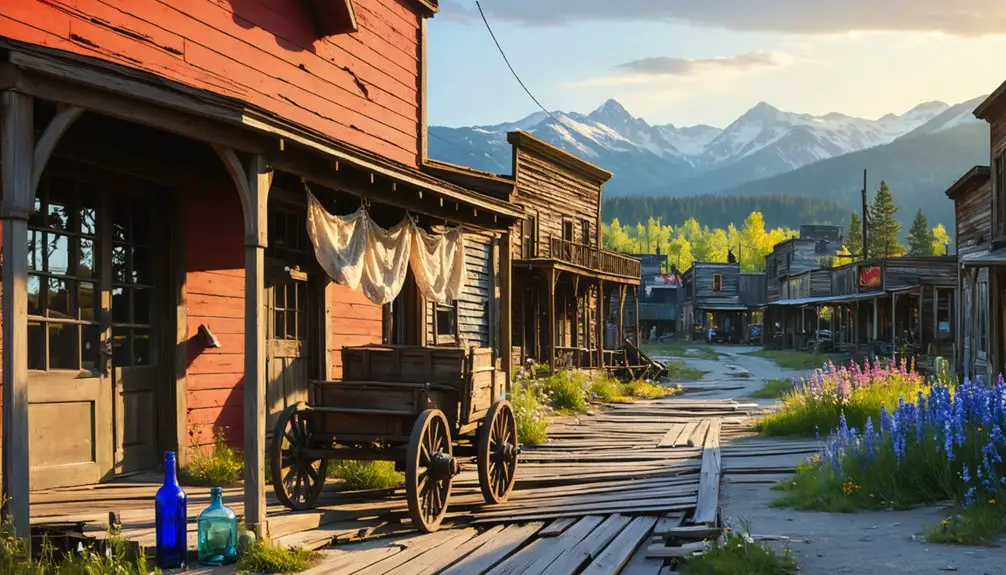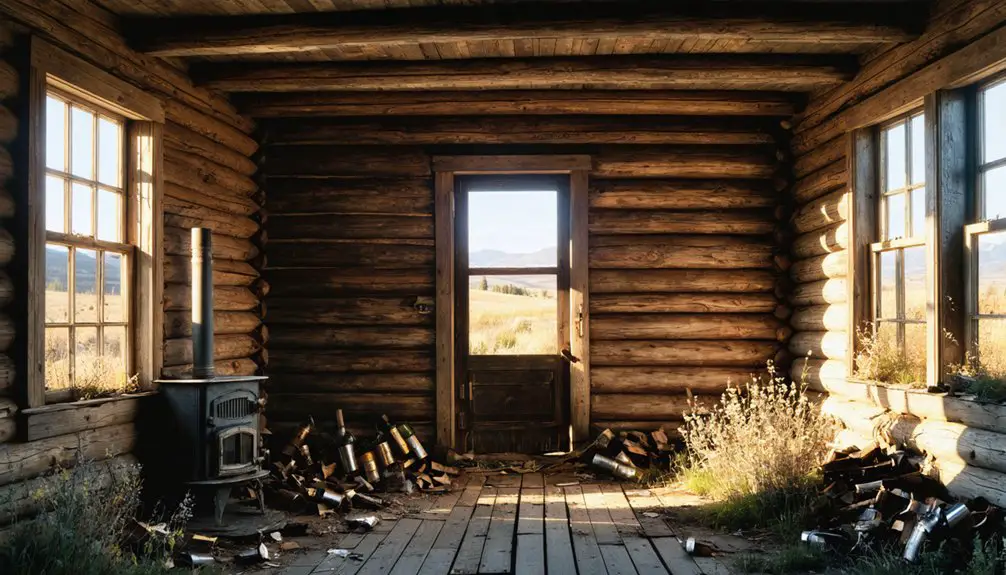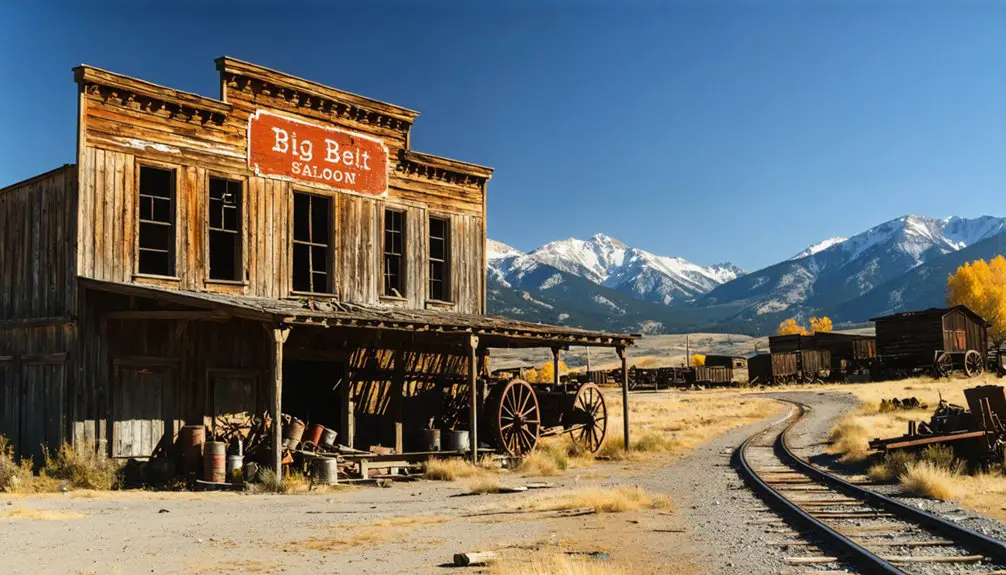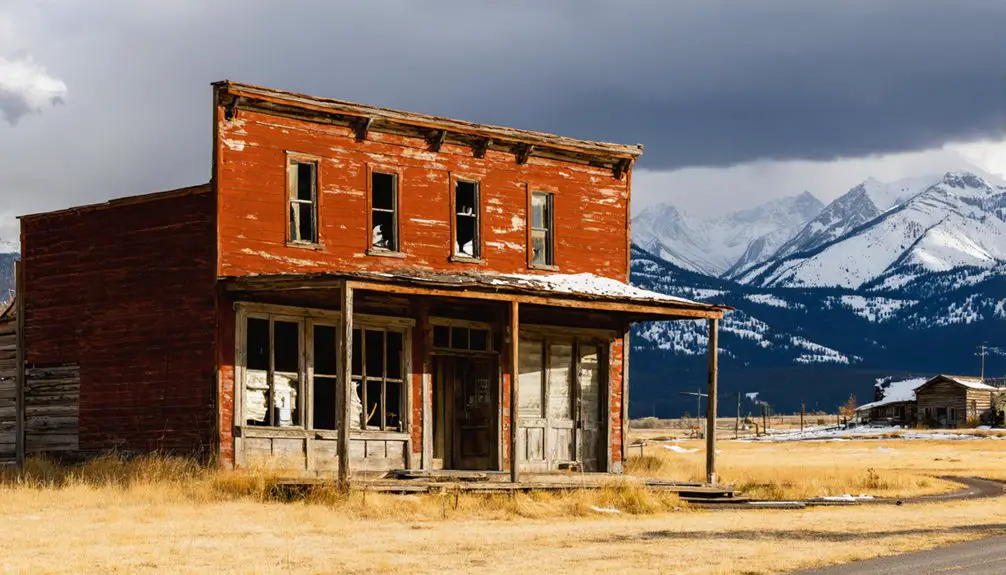You’ll find Red Lion ghost town along the North Fork of Flint Creek in Granite County, Montana, accessible via Discovery Basin Road from Georgetown Lake. This former mining boomtown, established in 1887, once housed 500 residents at an elevation of 8,061 feet. Today, you can explore the weathered foundations of the original mill and saloon while taking in scenic mountain views. Montana’s rich mining heritage awaits in these historic ruins.
Key Takeaways
- Red Lion ghost town is located in Granite County, Montana, along North Fork of Flint Creek, about five miles from Cable Campground.
- Established in 1887, the Red Lion Mine supported 200 miners and various businesses, with the community growing to 500 residents.
- The site includes visible remnants of the original mill foundations and saloon ruins, offering scenic mountain views at 8,061 feet elevation.
- Access is via Discovery Basin Road from Georgetown Lake, followed by a four-mile drive along a creek-side road.
- The town flourished during Montana’s mining era with social hubs, boarding houses, and community gatherings until economic challenges led to decline.
Discovering Red Lion’s Hidden Location

Tucked away in Montana’s rugged Granite County, Red Lion’s ghost town site lies along the North Fork of Flint Creek, approximately five miles from Cable Campground. This hidden treasure awaits at coordinates 46° 17′ 12″ N and 113° 11′ 57″ W, nestled in the historic Red Lion Mining District.
You’ll find the site by starting at Georgetown Lake and following Discovery Basin Road. After passing the North Fork of Flint Creek crossing, continue for about a mile until you reach Cable Campground.
Turn right onto the creek-side road and travel four miles upstream until you spot the road’s curve ascending the mountain ridge. The location’s geographical significance becomes apparent as you discover the foundations of the old mill, saloon, restaurant, and other remnants scattered near the creek, with the impressive Granite mines visible nearby.
The Gold Rush That Started It All
While gold was first discovered in Montana’s Gold Creek during the 1850s, it wasn’t until the major strike at Alder Gulch in 1863 that Montana’s legendary gold rush truly began.
The timing couldn’t have been more significant, as the Civil War raged and the Union desperately needed gold to finance its military campaigns. You’ll find that President Lincoln himself recognized the historical significance of Montana’s gold fields, actively promoting northern migration westward to secure these precious resources from Confederate interests.
Montana’s gold rush provided crucial funding for the Union, with Lincoln himself encouraging migration to keep the wealth from Confederate hands.
Within months, the region transformed as prospectors flooded west of Virginia City. Mining districts quickly organized, and by 1864, claims covered Alder Gulch completely. Mining districts established their own local governance and custom laws to manage claim locations and work requirements.
The gold mining boom sparked unprecedented growth, establishing essential settlements from Marysville to Virginia City, which became the territorial capital in 1865. Miners used picks and shovels as their primary tools, requiring intense physical labor to extract the precious metal.
Life in a Thriving Mining Community

You’d find Red Lion’s daily rhythm centered around its bustling mills and mines, where 200 miners worked alongside business owners and support workers who kept the town’s economy moving.
When you weren’t underground or running a business, you might’ve spent time at the saloon or boarding house, which served as essential social hubs for the town’s 500 residents.
The arrival of families gradually transformed Red Lion from a rugged work camp into a more structured community, complete with permanent homes and regulated business districts.
Daily Work and Commerce
Life in Red Lion centered around its bustling mining operations, where 200 miners worked demanding shifts extracting gold from the region’s replacement vein deposits.
You’d find workers enduring harsh labor conditions underground, drilling and hauling ore while battling hazardous environments typical of 1870s mining.
The town’s commerce revolved around supporting these operations. You could visit the blacksmith shop, where craftsmen maintained crucial mining equipment and produced horseshoes.
The mill operated day and night during peak times, processing ore continuously. Essential services included boarding houses, a saloon, and a restaurant catering to miners and their families.
A sophisticated tram system connected the mines to processing facilities, enabling efficient transport of materials through the mountainous terrain.
Family and Social Activities
Beyond the daily grind of mining operations, Red Lion’s social fabric wove together through vibrant community gatherings and family activities.
You’d find miners and townsfolk congregating at the local saloons, where music, card games, and storytelling created bonds among residents. Women played significant roles in shaping the town’s social structure, running boarding houses and organizing communal meals and church gatherings that strengthened family ties.
During seasonal festivals and dances, you could join celebrations that brought the entire community together. When you weren’t at organized events, the surrounding wilderness offered recreational escapes, with fishing in Flint Creek or hunting in the nearby mountains.
The community’s social support system extended beyond individual families, creating an informal network that helped residents navigate the challenges of frontier life.
Mining Operations and Economic Prosperity
While gold discovery sparked Red Lion’s initial development in 1875, the establishment of the Red Lion Mine in 1887 transformed this remote Montana settlement into a thriving mining community.
Underground mining techniques focused on replacement vein deposits, supported by extensive infrastructure including a mill, tram line, and essential services. At its peak, you’d find about 500 residents, with 200 miners working the claims.
Despite economic challenges posed by the rugged 8,061-foot elevation, the mine’s success drove remarkable growth. The mill operated day and night for six months during peak production, processing gold and some silver ore.
The operation’s prosperity rippled through the local economy, supporting numerous businesses from blacksmith shops to boarding houses, making Red Lion a significant contributor to Granite County’s development.
What Remains Today: A Walk Through History

Today’s visitors to Red Lion encounter a landscape where remnants of Montana’s mining heritage persist among mountain valleys and forested slopes.
As you explore the site via Discovery Basin road, you’ll find architectural remnants nestled within stunning natural surroundings, including foundations of the town’s essential structures and visible traces of the old tram line that once transported precious ore. Miners faced challenging conditions working twelve-hour shifts while earning three dollars and fifty cents per day.
- Original mill foundations stand as evidence to Red Lion’s gold processing operations
- Former saloon and restaurant ruins mark where miners once gathered after long shifts
- Blacksmith shop and boarding house remains reveal the town’s support infrastructure
- Weathered building sites offer scenic mountain views, particularly from old foreman residences
Exercise caution while exploring – unstable structures and variable road conditions can make access challenging, but the site provides an authentic glimpse into Montana’s mining past.
Exploring the Ghost Town Safely
Visiting Red Lion ghost town requires careful preparation and attention to safety protocols, given its remote mountainous location and deteriorating structures.
You’ll need to drive a 4-wheel drive vehicle on unpaved, steep roads and bring essential supplies including water, food, and emergency gear.
Key safety precautions include wearing sturdy hiking boots, carrying a first aid kit, and bringing proper clothing layers for sudden weather changes.
Follow visitor guidelines by staying on marked trails, avoiding unstable buildings, and watching for hazards like holes or falling debris.
Don’t explore alone – travel with companions and inform someone of your plans. Since cell service is unreliable, consider alternative emergency communication methods.
Remember to respect the site by not removing artifacts and packing out all trash to preserve this historic location for future visitors.
Legacy of Montana’s Mining Era

Montana’s mining era shaped not only Red Lion but the entire trajectory of the state’s development. From the 1860s onward, mining techniques evolved from simple placer claims to sophisticated industrial operations, contributing an estimated $150 billion in today’s dollars to Montana’s wealth. The mining archives repository at MBMG provides comprehensive documentation of this rich history through thousands of maps, engineering reports, and photographs.
Mining transformed Montana from frontier territory to industrial powerhouse, generating vast wealth through increasingly sophisticated extraction methods.
You’ll find evidence of community resilience throughout the state’s 6,000 historical hardrock mines, where boom-and-bust cycles created and transformed countless settlements.
- Mining operations continue to employ 2,600 workers across Montana, ranking 13th nationally in mineral production
- The industry focuses on valuable minerals like palladium, platinum, and copper using modern extraction methods
- Ten of Montana’s 56 counties remain centers of mining activity, preserving the state’s resource heritage
- The Montana Bureau of Mines and Geology safeguards invaluable historical mining data for future generations
Frequently Asked Questions
Are There Any Documented Paranormal Activities or Ghost Sightings in Red Lion?
You won’t find documented ghost encounters or haunted locations in official records, research papers, or historical archives. No verified paranormal activity has been reported at this former mining settlement.
What Happened to the Residents After Red Lion Was Abandoned?
Like scattered seeds seeking fertile soil, you’ll find their relocation stories led to nearby mining towns, cities like Missoula and Butte. Many pursued new trades, while others followed economic opportunities beyond Montana.
Did Any Famous Outlaws or Notable Historical Figures Visit Red Lion?
You won’t find any documented outlaw legends or historical visits from famous figures in Red Lion’s history. The remote mining town’s records show it remained focused on everyday mining operations.
Were There Any Major Accidents or Disasters During Red Lion’s Mining Operations?
You’ll find records of mining accidents near Red Lion during its operational period, but no major disasters on the scale of Montana’s Smith Mine or Granite Mountain-Speculator catastrophes are specifically documented there.
What Native American Tribes Originally Inhabited the Red Lion Area?
Like bison moving across boundless plains, you’ll find the Crow (Apsáalooke) tribe originally claimed this land. They maintained tribal history and cultural significance here until Lakota Sioux incursions in the 1800s.
References
- https://ghosttownfinder.com/towns/red-lion-montana
- https://www.legendsofamerica.com/mt-ghosttowns/
- https://scholarworks.umt.edu/mtghosttowns_audiorecordings/
- https://ghosttownfinder.com/explore
- https://www.youtube.com/watch?v=ysgpF2jrvc8
- https://www.coordinatesfinder.com/coordinates/1597463-red-lion-pa
- https://www.geocaching.com/geocache/GCXH3H
- https://deq.mt.gov/files/Land/AbandonedMines/documents/ProjectDocuments/RedLodge/Final Report MDEQ_RedLodge_501BroadwayAveS.pdf
- https://www.mindat.org/feature-5673388.html
- https://mhs.mt.gov/education/textbook/chapter6/Chapter6.pdf



